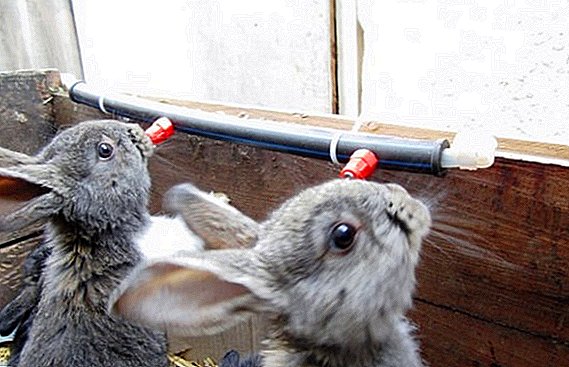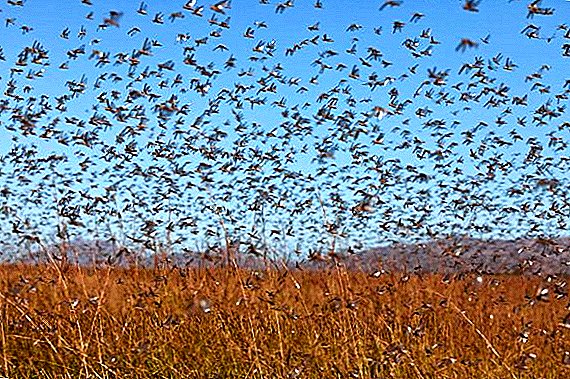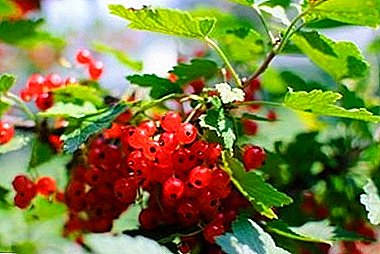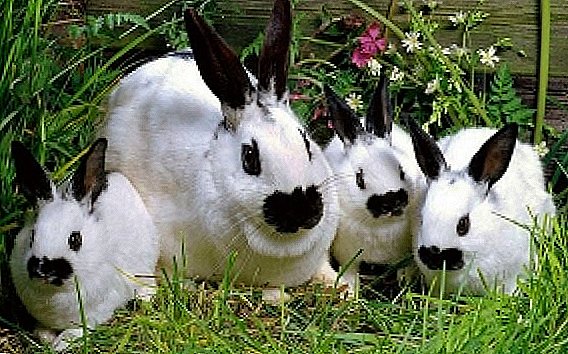 Rabbit breeding is becoming increasingly popular among farmers. First, in comparison with other agricultural animals, most of them do not require any special troubles in care and feeding. Secondly, quite prolific. And, finally, they have delicious meat and skin, which are readily bought. In short, rabbits give a good income.
Rabbit breeding is becoming increasingly popular among farmers. First, in comparison with other agricultural animals, most of them do not require any special troubles in care and feeding. Secondly, quite prolific. And, finally, they have delicious meat and skin, which are readily bought. In short, rabbits give a good income.
Do not make an exception and rabbits breed Butterfly.
Description
 Rabbit Butterfly - meat and animal breed, slightly larger than the average size. The weight of adults is about 4.5–4.8 kg, and in some cases up to 5 kg. Torso length - 54 - 56 cm.
Rabbit Butterfly - meat and animal breed, slightly larger than the average size. The weight of adults is about 4.5–4.8 kg, and in some cases up to 5 kg. Torso length - 54 - 56 cm.
In rabbits of the Butterfly breed, there is a strong constitution of the body, a wide chest and back, the legs are straight and muscular. Medium sized head. In males it is round, and in females it is elongated. Ears are upright, 14 - 16 cm long. The skin of this breed is shiny, rather thick.
Appearance
 The breed received its name due to the fancy butterfly-shaped pattern with its wings open on its nose. The rabbit itself is white. On the cheeks, the back of the carcass on the sides there are dark spots contrasting with the base color. The eyes are dark. The eyes are surrounded by a continuous border of dark pigment. In addition, in the rabbits of this breed of dark color, the ears, and along the entire back, from the base of the ears to the tip of the tail, passes a wavy dark stripe.
The breed received its name due to the fancy butterfly-shaped pattern with its wings open on its nose. The rabbit itself is white. On the cheeks, the back of the carcass on the sides there are dark spots contrasting with the base color. The eyes are dark. The eyes are surrounded by a continuous border of dark pigment. In addition, in the rabbits of this breed of dark color, the ears, and along the entire back, from the base of the ears to the tip of the tail, passes a wavy dark stripe.
By the color of the spots, the Butterfly breed is subdivided into black, blue, yellow and gray.
Productivity
 Butterfly Rabbits are especially prized for their unusually beautiful shiny fur. As a rule, skins do not require additional cosmetic treatment. And in their natural form are in great consumer demand.
Butterfly Rabbits are especially prized for their unusually beautiful shiny fur. As a rule, skins do not require additional cosmetic treatment. And in their natural form are in great consumer demand.
From the skins of butterflies sew hats, bags, winter outerwear. In this case, furriers, even with the color of the skin itself, try to keep the original design on it. The meat of this breed of rabbits is very tasty. But the slaughter of his output is small and amounts to only 53 - 55%.
Advantages of the Butterfly breed:
- Original color shiny skin
- Fecundity of females
- High survival rate of baby rabbits
- Unpretentious care and feeding

Breed deficiencies:
- Have a too large basement and a short back.
- When crossed with other breeds, the shape of the color is disturbed and the quality of the skin decreases.
- Sensitive to improper care.
- The bunny rabbit sometimes eats its offspring
Peculiarities of care
 Rabbits do not require special care. The best way to breed them is in the cells. They are quite easy to tolerate heat and cold. But can get sick from drafts.
Rabbits do not require special care. The best way to breed them is in the cells. They are quite easy to tolerate heat and cold. But can get sick from drafts.
To prevent diseases, it is also necessary to change the litter in the cells daily in order to avoid the accumulation of urine and feces.
And, of course, they need to be vaccinated.
In food, they are unpretentious. In the diet should be green plants, boiled potatoes, solid juicy food (carrots, sugar and fodder beet, etc.), protein, vitamin, mineral food.
 Rabbits of this breed also happily gnaw the branches of fruit trees, tops of garden plants, and hay. But hay should not contain poisonous herbs (celandine, dope and the like), as by eating poor-quality hay, the butterfly can be poisoned.
Rabbits of this breed also happily gnaw the branches of fruit trees, tops of garden plants, and hay. But hay should not contain poisonous herbs (celandine, dope and the like), as by eating poor-quality hay, the butterfly can be poisoned.
Overfeeding them is not necessary. This is especially true of individuals that are kept for breeding. Obese males and females will have small offspring, while females will not have enough milk.
A distinctive feature of other breeds in Butterfly rabbits is that they drink a lot. Therefore, in the cells should be all the time water. Basic feeding rules:
Feed at least 2 times a day (otherwise there will be poor-quality meat and skin);
Be sure to give vitamins;
Constantly giving hardwoods so as not to gnaw the wooden parts of the cage;
Do not feed with book fruits (otherwise there may be an upset stomach, bloating).
Okrol
Butterfly breed females are very prolific. Of great importance is not only the correct selection of the male and the age of reproductive couples, but also the gentle and, at the same time, rich in minerals and proteins, feeding of the pregnant female.
The outburst of young individuals is 8 rabbits, but more mature ones can be large (up to 16 rabbits). Dairy mothers and mostly well cared for their young. But there are cases and eating newborn rabbits. Therefore, the farmer must be present at okrol. And in case of trouble in time to take away the babies from the female.
Births usually take place at night. Lasts 15 - 20 minutes, but there are also longer in time - up to an hour. After okrol the female must be given a drink. Like all breeds, rabbit breeds of the Butterfly are born without wool. The female licks them and carries them to a nest made of hay and fluff so that they do not freeze. Lactation in rabbit lasts an average of 12 weeks. But newborn rabbits consume half as much milk as early as 24 days old, adding more plant food to their diet. And on the 35th day from the moment of his birth, they completely refuse milk.
At weaning from the mother, the rabbits are sorted by fatness, live weight and sex.
Separately placed those individuals that are lagging behind in growth. The reason for this is that they are most susceptible to diseases and can infect all young. Rabbits with a small mass are kept in separate cages and fattened for meat.
Upon reaching 3 months of age (during this period, they just begin puberty) are transplanted into cages to adult rabbits.
Rabbit food should be gentle and gentle. Herbal flour, premixes, bone meal, dicalcium phosphate, tricalcium phosphate, phosphorin are necessarily introduced into the diet of their food. Very carefully in food introduced green feed. A solid juicy - until adulthood is generally prohibited.
The diet of baby rabbits, weaned from the female in the dairy period, is made up of protein feed. This, above all, whole milk and cream, taken from milk, milk powder, whey, buttermilk.
Weaned rabbits that have not yet reached adulthood cannot be overfed. Otherwise they may have frequent indigestion, bloating, diarrhea.












